After a trek through the primary and secondary rainforests, sometimes through narrow tracks, other times through wide open fields, with expert gorilla guides who slash through the dense vegetation, or clear the way through towering bamboo forests as the cicadas sing you along, suddenly, your guide makes a loud gorilla call. The sweat drips off your forehead, your calves burn, and maybe your legs even sting ever-so-slightly from the stinging nettle—but it’s worth it. The trackers who left early in the morning to trek deep in the forest call back—the gorillas are nearby. As you get closer, the guide stops you in your tracks, asks you to put your face mask on and take with you only what you need: your camera and an open heart. “The gorillas are here. Lower your voices and let’s go meet them,” says your guide.
To understand the behavior and human-like nature of these rare and precious primates (they share 98 per cent of our DNA, a close second in similarity to humans after chimpanzees, who share 99 per cent of our DNA), one must journey to where they roam in the misty rainforests of central Africa to come face-to-face with our not-so-distant relatives. The hour you get to spend with the mountain gorillas in Africa—charismatic, magical forest creatures—is sure to change your life, as you watch their solo and group behaviours as a family unit. Based on our personal gorilla trekking experiences, Volcanoes National Park in Rwanda, Bwindi Impenetrable National Park and Mgahinga Gorilla National Park in Uganda, Odzala-Kokoua National Park in the Republic of Congo, and Virunga National Park in the Democratic Republic of the Congo (which we’re currently pausing travel to due to unrest) support sustainable gorilla observation in a safe and protective way. As gorillas strive to survive in our modern day, any time spent with them at the following national parks is an exceptional experience. There are four different types of gorillas: mountain gorilla, Grauer’s gorilla, western lowland gorilla, and cross river gorilla (only found in Nigeria and Cameroon).
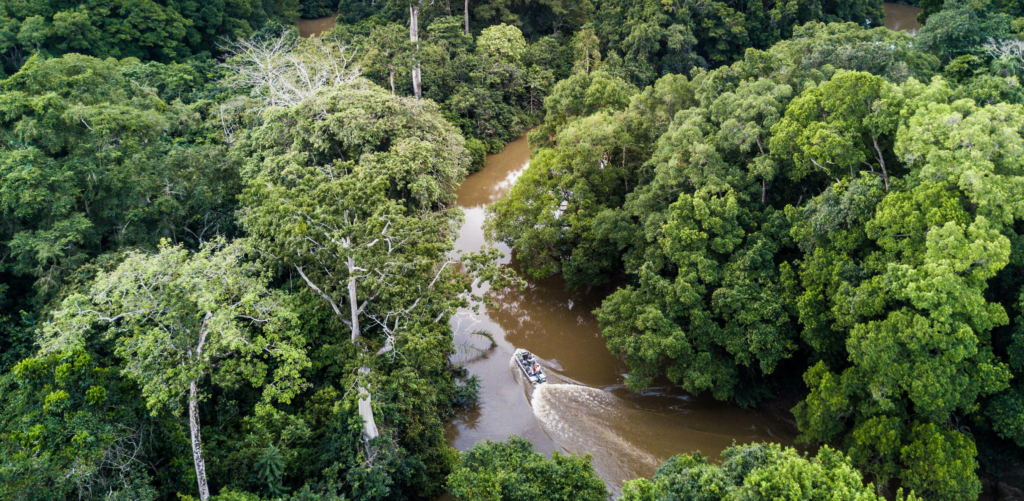
Where do gorillas live?
Wondering where to see gorillas in Africa? We’re all about Extraordinary moments, and especially unique wildlife encounters over here at Extraordinary Journeys, and there’s truly nothing quite like that moment when you first lock eyes with a mountain gorilla in their natural habitat. Gorillas are confined to the forests of Central Africa, and the majority live in the Congo Basin—the second largest tropical rainforest left on earth. Mountain gorillas are an exception, and they are found east of the basin in the Albertine Rift. Their high mountain forest homes are located in the subtropical forests of Sub-Saharan Africa in Rwanda, Uganda, the Republic of Congo, and the Democratic Republic of the Congo.
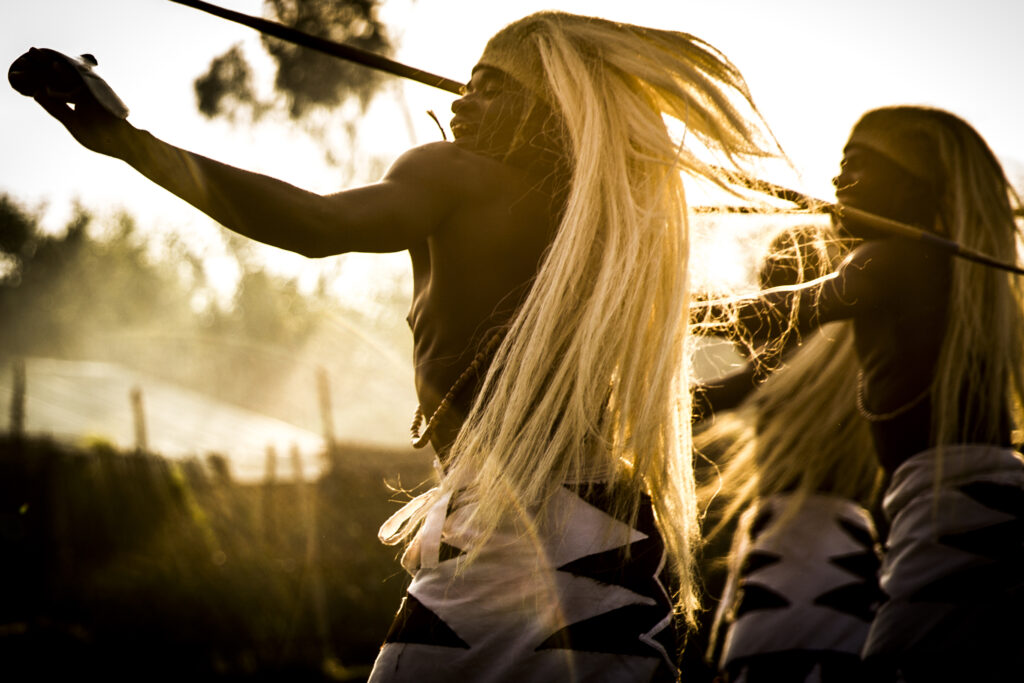
Rwanda
Rwanda is home to half of the world’s remaining mountain gorilla population. Going on a gorilla safari in Rwanda is the most accessible and has the most options for different lengths and difficulties of treks. Of note is that it’s generally much easier to reach Rwanda’s mountain gorillas in the wild than in Uganda. Also, for those on a time crunch, Rwanda’s Volcanoes National Park is just a three-hour drive from Kigali. For those really pressed for time, we can also arrange a private helicopter from Kigali.
Rwanda also combines easily with a Kenya or Tanzania safari as a two- or three-day add-on. There are daily flights from Nairobi and parts of the Serengeti, and it is only a 2.5-hour drive to get to the rainforest.
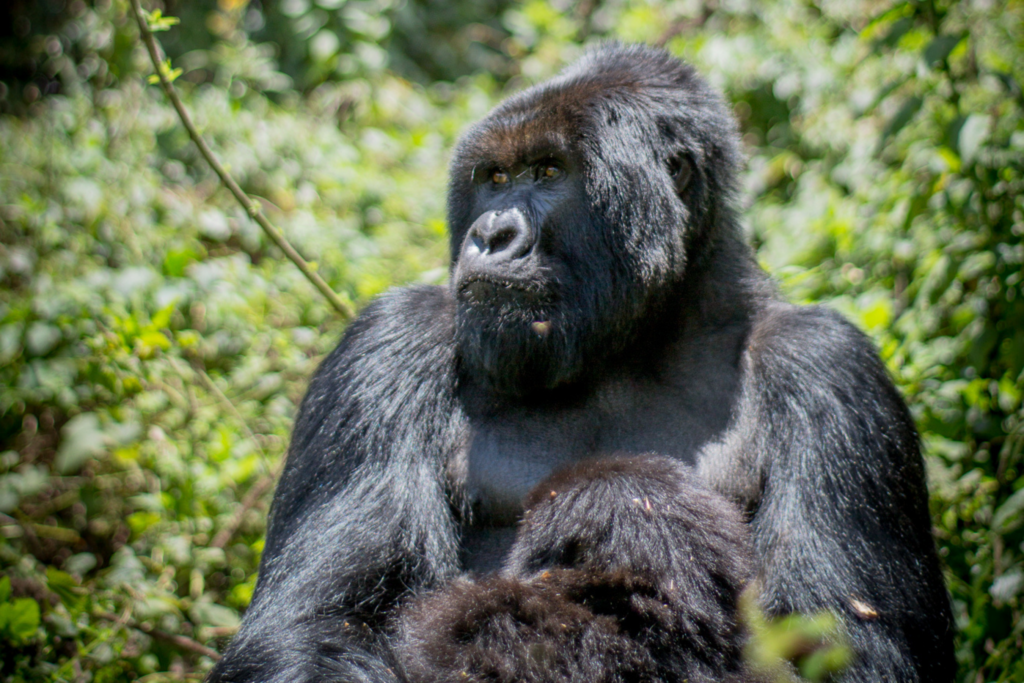
Where to see gorillas in Rwanda
Located in the northwestern corner of the country is the world-famous Volcanoes National Park, in the small town of Musanze. It’s the oldest national park in Africa, and the rainforest is home to one of the highest populations of these beautiful primates, with 178 of them making up 10 habituated gorilla groups of varied sizes, ranging from 11 to 33 family members. History buffs will appreciate that you can follow in the footsteps of American primatologist and conservationist Dian Fossey, who famously studied the Gorillas in the Mist (the title of her book and film) here and brought worldwide attention to the importance of their conservation. A must-see is the new Ellen DeGeneres Campus of the Dian Fossey Gorilla Fund. The multi-acre, eco-friendly facility adjacent to the Volcanoes National Park includes three main buildings—the Sandy and Harold Price Research Center, the Rob and Melani Walton Education Center, and the Cindy Broder Conservation Gallery—as well as housing for visiting students and researchers. The Ellen Campus now serves as a gateway to conservation for the many stakeholders with whom we work, helping to create the next generation of conservationists.
Wondering where to stay in Rwanda’s Volcanoes National Park during your gorilla safari? There are some totally incredible properties right in the forest, overlooking the twin lakes and more. Check out some of our favorite experiences on the blog here.
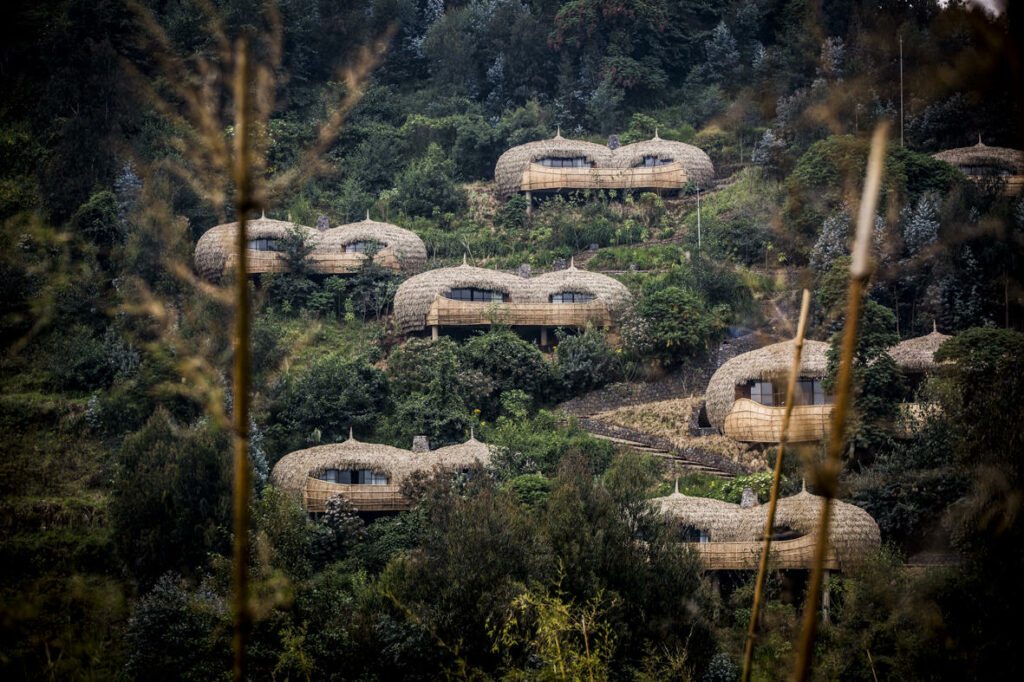
When to see gorillas in Rwanda
Gorilla trekking is a year-round activity, but like any rainforest, it’s easier to trek in the dry seasons, which are mid-December to early February and June to September. Park rangers track the groups’ movements year-round, so if you don’t mind muddy boots, the opportunities are still there when the rains come down—just bring your most waterproof gear (pants, jacket, warm hat, and you’ll be totally comfortable). In the wet season, the air is crystal clear, so you’ll find great views of the volcanoes, and gorillas tend to hang out on the lower slopes of the mountain.
How much does it cost to see gorillas in Rwanda?
To support conservation efforts, the Rwanda Development Board only issues 80 gorilla permits daily for $1,500 per person per trek—with a max of eight people allowed per group. Each trekking group is assigned a gorilla family by a ranger on the day of their trek, according to group size and fitness levels. The permit grants you an hour-long experience with a gorilla group once a park ranger locates them. This price may seem steep, but you’ll be in one of the cleanest, most progressive model nations on the continent, and the data shows how successful this conservation model is. In fact, they are the only primate species whose numbers are increasing. Also, 10 per cent of what you pay goes to surrounding communities. The gorilla safari experience in Volcanoes National Park is highly organized, with free coffee provided by every morning before your trek by Rwanda’s famous coffee shop, Question Coffee.
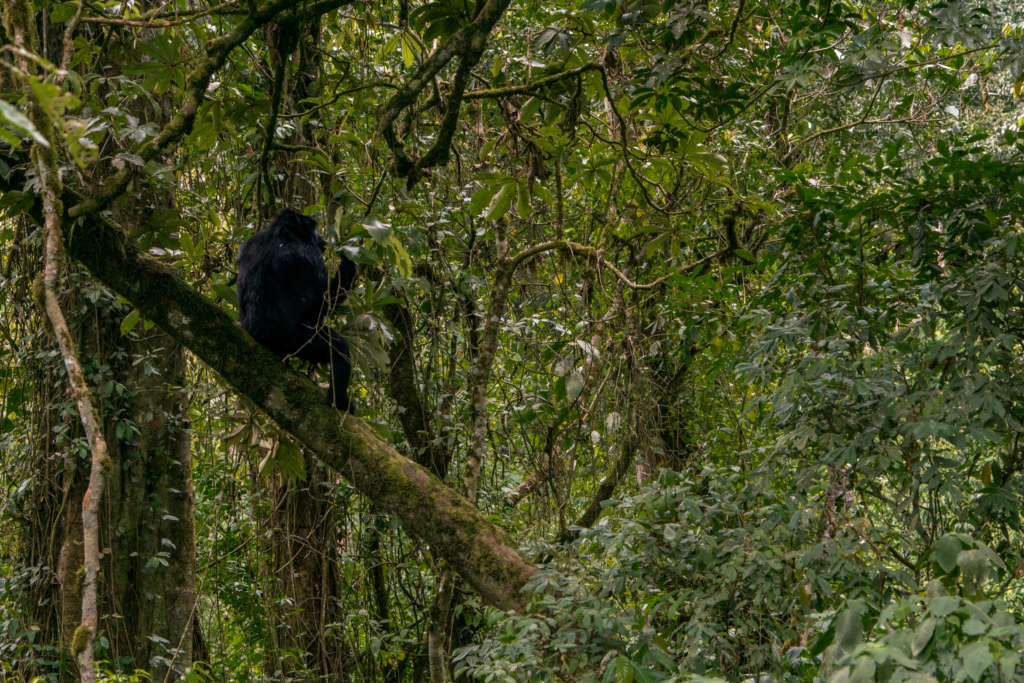
Uganda
Uganda is an Eden of rainforest and lush vegetation, balanced by vast stretches of grassland, lakes and rivers. Most notably, Uganda is home to half of the world’s mountain gorilla population and is one of the few countries where you can encounter them in their natural environment. In addition to mountain gorillas, Uganda boasts a dozen other primate species, including groups of chimpanzees and golden monkeys, which you can also trek to.
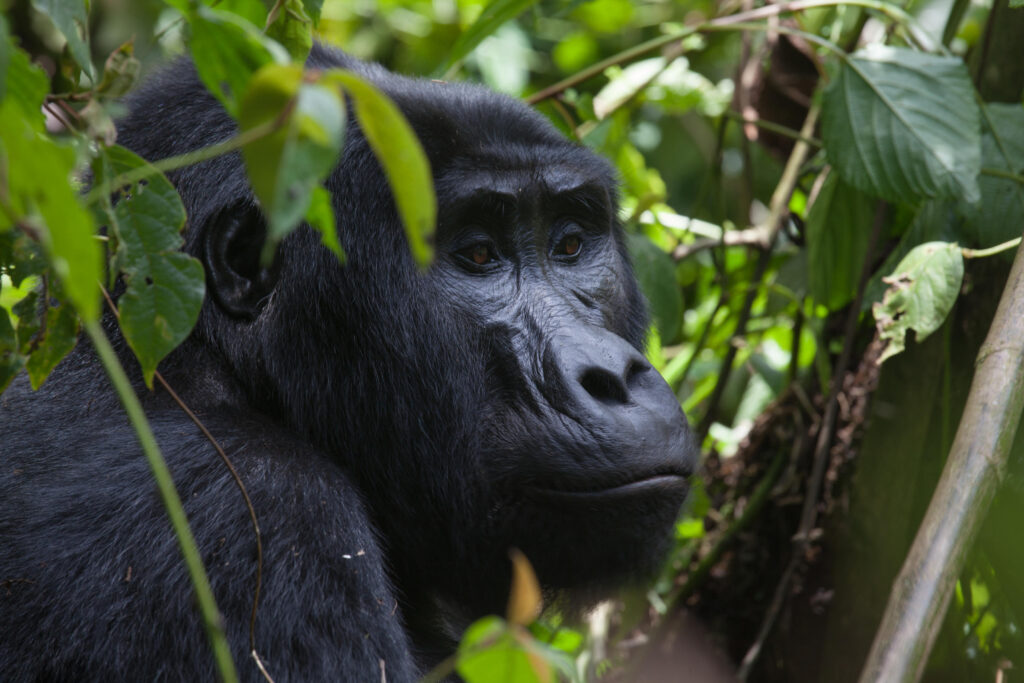
Where to see gorillas in Uganda
There are a couple of options for a gorilla safari in Uganda. Travelers can opt for Uganda’s smallest national park Mgahinga Gorilla National Park, where there is only one habituated gorilla family, the Nyakagezi group. This group is very special in that they are used to humans and are very relaxed and curious when you trek to them—almost allowing you to become a part of their family.
The larger and more popular place to trek is Bwindi Impenetrable Forest National Park, about 30 miles north of Mgahinga. It’s the protected, lush-green abode for more than 400 mountain gorillas, half of the world’s remaining population. A guided trek can bring you to one of 11 family groups with a total of over 160 members, including adorable, must-see gorilla babies. Serious adventurers may want to add the Gorilla Habituation program to their itinerary for a more exclusive experience. This intimate, four-hour hike in Rushaga (the southern part of Bwindi) offers an incredibly unique and rare encounter; meeting gorillas that are not yet fully habituated means you get to help introduce them to human interactions.
Wondering where to stay in Uganda while gorilla trekking? Check out some of our favorite experiences on the blog here.

When to see gorillas in Uganda
Gorilla trekking in Uganda is available anytime, but most people go during the two dry seasons: January to February and June to September. It may be advantageous to opt for the rainy season when the apes are just as present, and there’s less competition to secure one of the limited 96 gorilla permits issued per day.
How much does it cost to see gorillas in Uganda?
A gorilla trekking permit in Uganda is $700 regardless of what season you go, and 75 per cent of the money raised is to conserve the gorilla surviving population. The government takes 15 per cent, while 10 per cent is reserved for the local communities around the parks. As you purchase the permit, note that the cost includes park entrance fees, gorilla watching for an hour, advance trackers and ranger fees. The permit for Gorilla Habituation is $1500 with a max of four people per group. Warning: Trekking across these regions is not for the faint-hearted, thanks to elevation gains of up to 7,500 feet in humid and muddy conditions. It’s a long drive from the capital (nine to 10 hours) to Bwindi, so we like to combine Uganda trekking into a five-day, or longer, safari to explore other areas of the country. If you can’t swing a few extra days, there are also daily flights from Entebbe to the Bwindi Impenetrable forest.
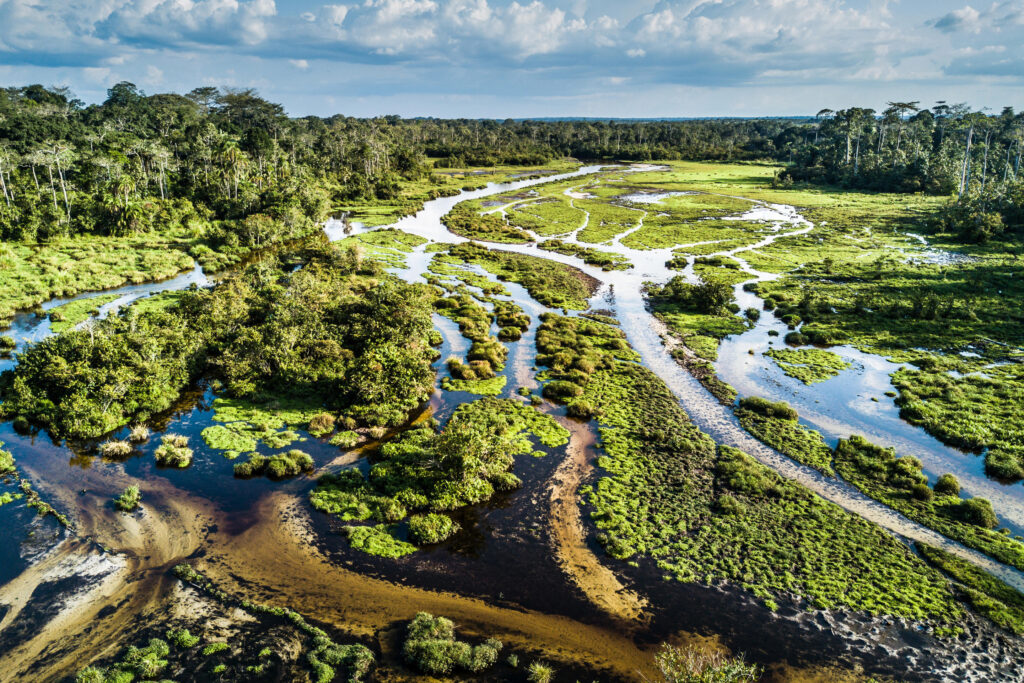
The Republic of Congo
Where to see gorillas in the Republic of Congo
Head west to Odzala-Kokoua National Park, which includes the vast Congo rainforest basin. This expanse of dense trees, bushes and marshes is known for African forest elephants as well as one of the most diverse primate populations on the continent. It is also believed to have the highest number of western lowland gorillas in Africa. Temperatures are generally hot and muggy, but for the intrepid traveler, it is an amazing opportunity to visit a gorgeous, almost untouched area.
This is an amazing adventure for seasoned African travelers. You must be willing to tolerate some discomforts (heat, humidity, and insects), but you’ll be rewarded with astounding wildlife diversity in one of the most remote regions in the world.
As if the wildlife weren’t impressive enough, we’ve really fallen for Odzala as an authentic exploratory destination: from following rainforest trails and game driving across savannahs to boating, kayaking or river-wading through the area’s rivers, baïs and swamps, Odzala feels like a world apart. If you opt for the seven-day program, charter flights will whisk you between camps.
Wondering where to stay while gorilla trekking in the Republic of Congo?
When to see gorillas in the Republic of Congo
It’s best to go during the dry seasons, from June to September or December to February. Not only do these times allow for better odds for sightings of lowland gorillas gathering fruits, but it’s also when the roads to these parks are less prone to flooding and, therefore, more accessible.
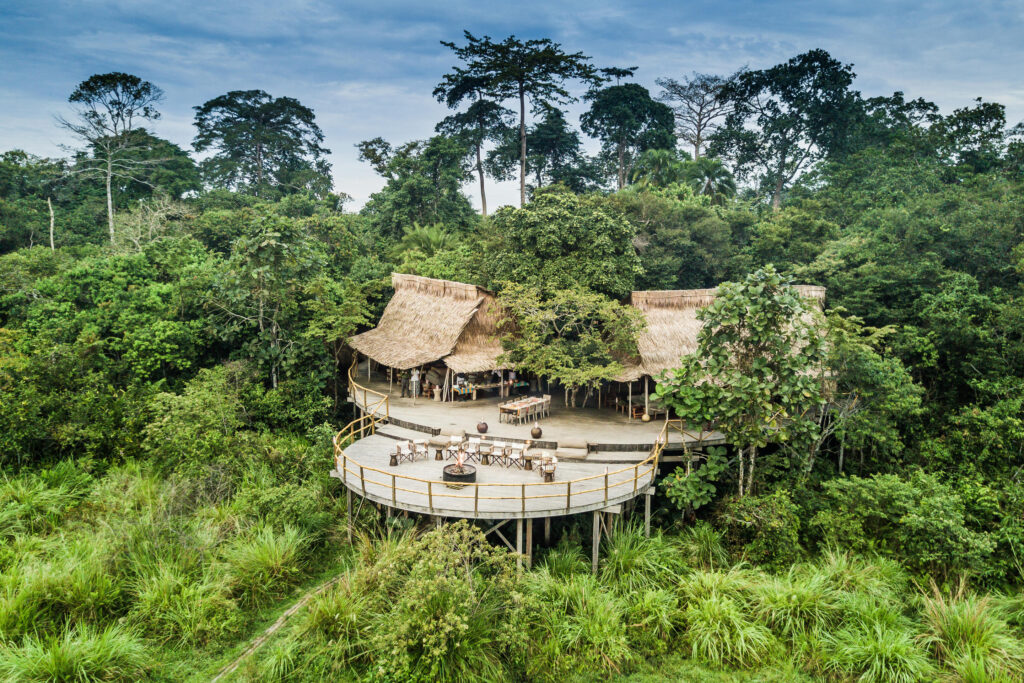
How much does it cost to see gorillas in the Republic of Congo?
Gorilla permits here are very affordable at $355 per person, but visiting Odzala is more than just seeing gorillas. We recommend spending at least a week so you can get the full experience of staying at all three camps and seeing some of the rarest species of African wildlife, such as the forest elephant, forest buffalo, bongo, sitatunga and many monkey species, not found elsewhere.
NOTE: The US government currently advises travelers to reconsider travel to the Democratic Republic of Congo due to crime and civil unrest. Some areas have increased risk. The Democratic Republic of Congo is still recovering from a war conflict that ended in 2003, and civil unrest continues to plague parts of the country.
However, the government is looking to tourism as a means to come together to build much-needed infrastructure and move on. The extreme impact of tourism here is part of why we love it; camps are run by the national park, and all revenue goes back into supporting gorilla protection. When it is safe to travel here again, we will encourage it, but for now, this destination is on pause for Extraordinary Journeys.
The Democratic Republic of Congo
TO NOTE: In accordance with national travel advisories for the Democratic Republic of the Congo, we have currently paused all sales of travel to the DRC and Virunga National Park due to crime and civil unrest (not to be confused with the Republic of Congo, which is safe to travel to). We will resume tourism operations here once it’s safe to do so—your safety is our top priority.
Where to see gorillas in the Democratic Republic of Congo
The rainforest-covered volcanoes that host many mountain gorilla habitats across the borders of Uganda, Rwanda, and DR Congo are known as the “virungas,” or volcanoes. Hence, the namesake Virunga National Park in the central-eastern part of this country. More than 100 mountain gorillas reside in this UNESCO World Heritage Site, the oldest national park in Africa. Eight accessible gorilla groups roam within, the largest featuring 26 members in the Bageni clan. However, dueling silverbacks may change group dynamics as family drama is continual amongst these extremely societal animals. Don’t worry, the gorillas don’t appear to have much drama with visiting tourists.
Wondering where to stay while gorilla trekking in the Democratic Republic of Congo? Check out this blog post on some of our favorite experiences.
When to see gorillas in the Democratic Republic of Congo
Like its neighbors in Rwanda and Uganda, DR Congo has better and drier opportunities to see mountain gorillas from January to February and June to September. However, when the rainfall starts, the gorillas don’t exactly go into hibernation, making gorilla trekking a year-round affair.
How much does it cost to see gorillas in the Democratic Republic of Congo
Gorilla permits are less expensive than its immediate neighbors, starting at $400 per person. To make this trip extra rewarding, visit the Senkwekwe gorilla orphanage, or spend a magical night sleeping on the edge of Nyiragongo Volcano at 11,383 feet. Plus, Virunga National Park is only three hours from Kigali by car, making it extra convenient.
FAQs about seeing gorillas
What part of Africa has the most gorillas?
The highest population of mountain gorillas is in Africa, and they live in the Virunga Mountain Range, which stretches across three countries, Rwanda, Uganda, and the Democratic Republic of the Congo.
Is it better to see gorillas in Uganda or Rwanda?
Both destinations are excellent places to see gorillas. Volcanoes National Park in Rwanda is the most easily accessible. In Uganda, there are two options to trek: Bwindi Impenetrable Forest National Park, which has 13 groups and around 400 gorillas, and Mgahinga National Park, with just one habituated group.
Bwindi also offers the Gorilla Habituation Experience, where you’re able to spend up to four hours with a semi-habituated group. They’re less predictable and not as relaxed with humans as habituated groups, and it’s a fascinating, intimate glimpse into how gorillas gradually get used to humans. At US$1500, it’s the same price as one hour with Rwanda’s mountain gorillas.
What can I expect from a gorilla safari?
There’s nothing quite like coming face-to-face with a gorilla. They seemingly stare deep into your soul, and it’s one of the most extraordinary wildlife encounters on earth. Getting to have a one-hour glimpse into their lives in the forest is so unique and special. Of course, you’re trekking in the wilderness, and along with that comes heat, humidity, and insects.
Is gorilla trekking worth the money?
The cost of gorilla permits is essential to preserving the gorillas’ habitats and supporting local communities. So yes, it is worth the money. The cost ensures the sustainability of conservation initiatives, funds development projects, and enhances all visitors’ experiences.
Are gorillas friendly?
Gorillas are known to be very quiet, charismatic, and peaceful animals. Every gorilla group has a different dynamic, and every trek will be a completely different experience, depending on their mood, what’s happened in the family, and whether or not they’ve eaten. Sometimes you’ll encounter them on a serious day, where they look deep into your soul and stay in one place. Other times you’ll find them in a very playful mood, with lots of babies, swinging from tree to tree and rolling around. That’s the beauty of a gorilla trek, you could do it 100 times, and every single experience will be unique and different, which is why we recommend trekking at least twice, and to two different families when possible.
What to do if a gorilla approaches you?
More often than not, the gorillas are going to want to approach you. Curious by nature, the younger gorillas may come right up to you and even reach for you or your belongings. That’s why the guides are there to ensure a safe distance between you and the gorillas. Sometimes they will playfully charge at you, in which case the guides will get between you and the gorillas in order to ensure your safety and theirs. Other times they may brush right by you.
It’s very important to wear a mask. Gorillas share 98 per cent of our DNA and are susceptible to human diseases, including COVID-19 and the flu.
Do gorillas bite?
Generally, gorillas are very shy. The only time they may attack is if they were threatened or a human isn’t following the rules outlined during the briefing. Never run away when they approach, and always make slow movements. An unexpected movement could result in a male silverback male can react with horrific roaring and bluff charges.
That said, gorillas have large canines that give bites that are incomparable to any of those carnivores like lions and crocodiles. A bite from a gorilla can cover about 1,300 pounds per square inch, which is way higher than predatory lions, which have 650 pounds per square inch.
Plan your gorilla safari with us
Call or email us to learn more about how you can see gorillas in the wild.

Where to See Gorillas in Africa: The Best Destinations
The best places in the world to see gorillas are Congo, DRC, Uganda, & Rwanda. Find out…
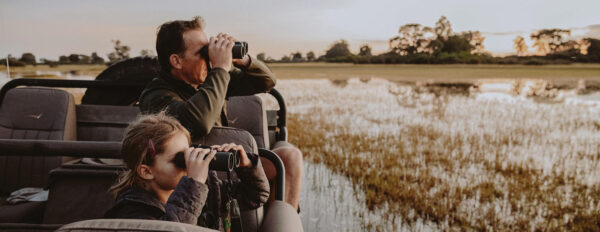
The Ultimate Guide to Family Safari
Extraordinary Journeys co-founder Elizabeth Gordon provides tips and activities to do…

The Best Luxury Safari Lodges in South Africa
When it comes to high-end lodgings, the best safari lodges in South Africa are a trifecta…
